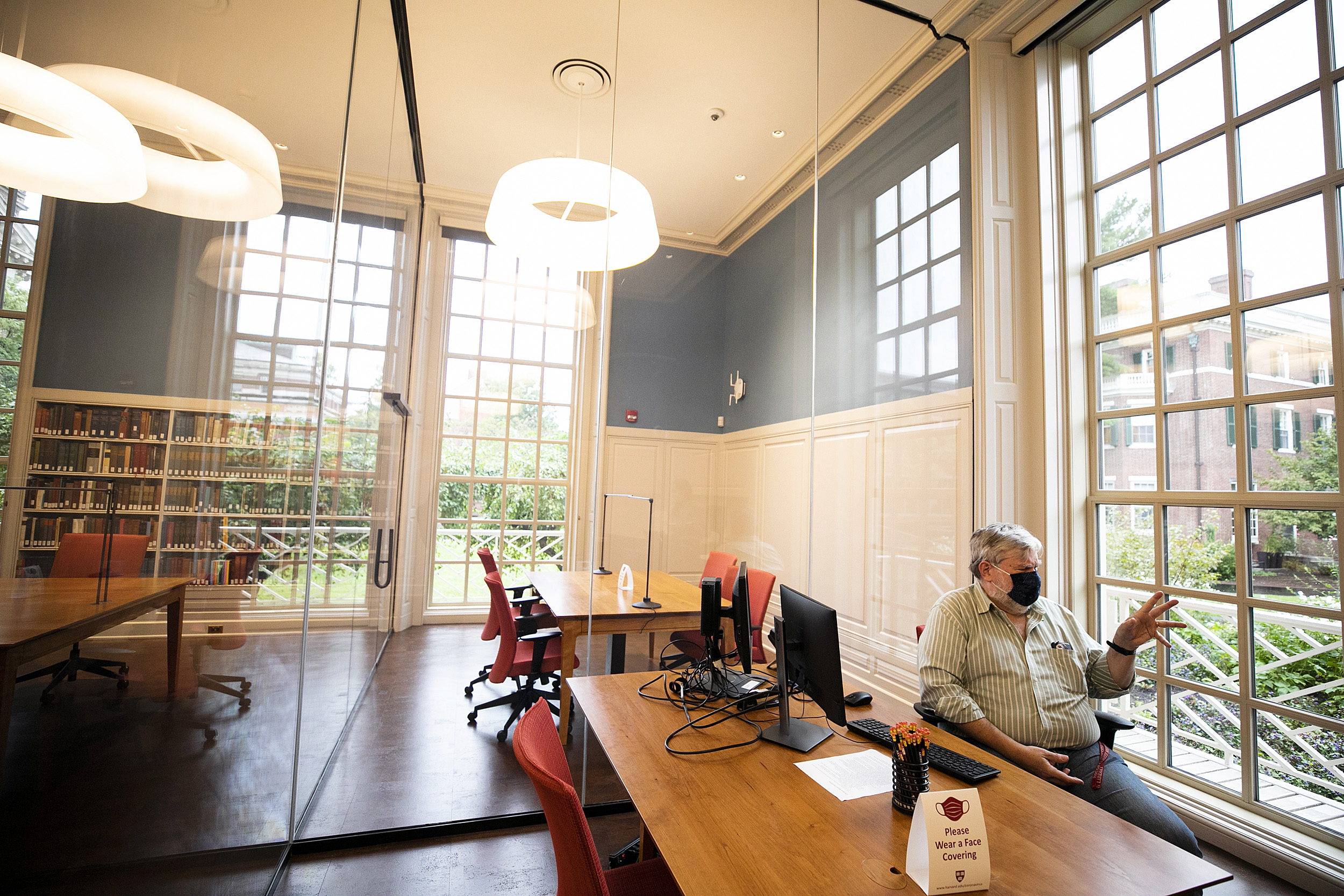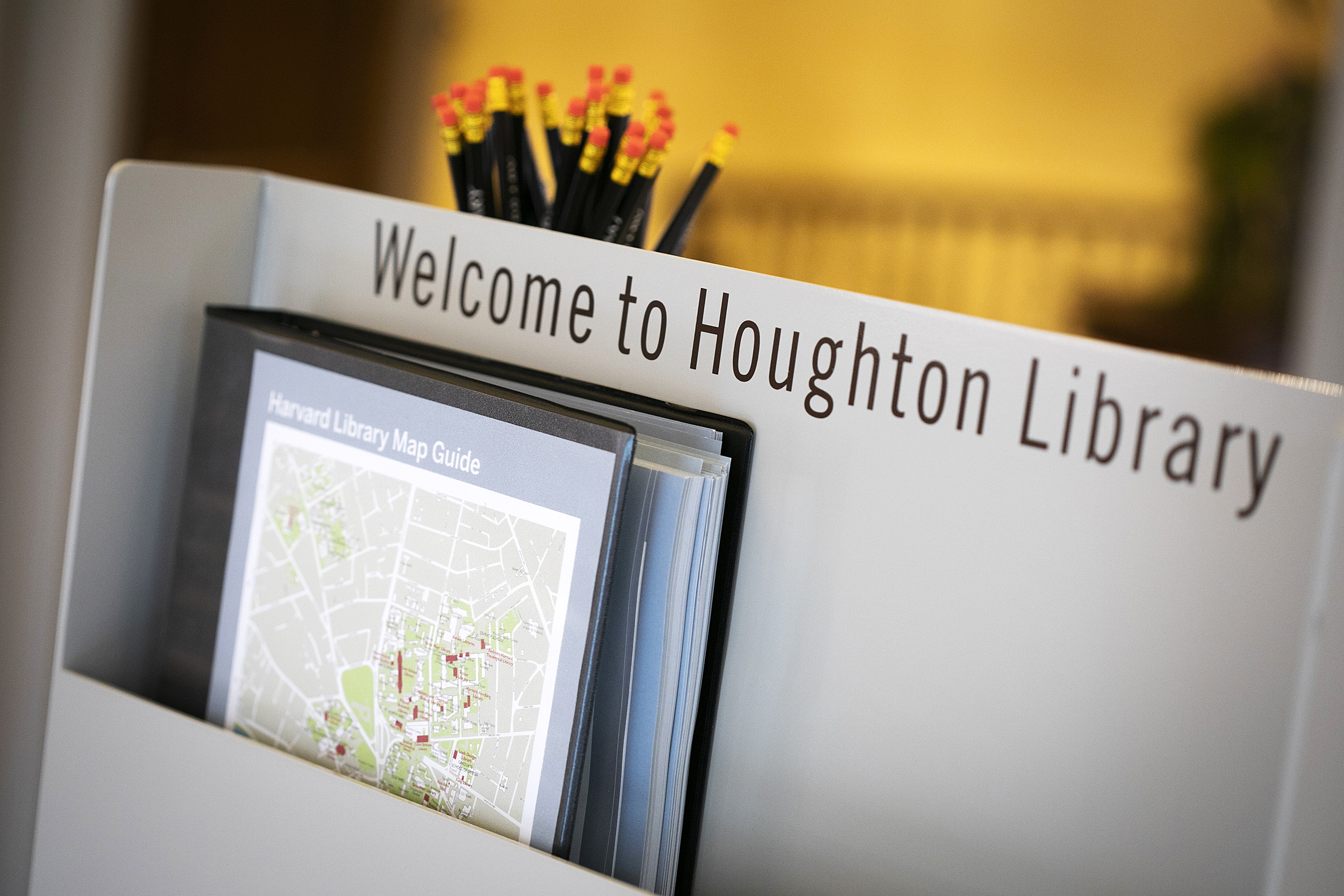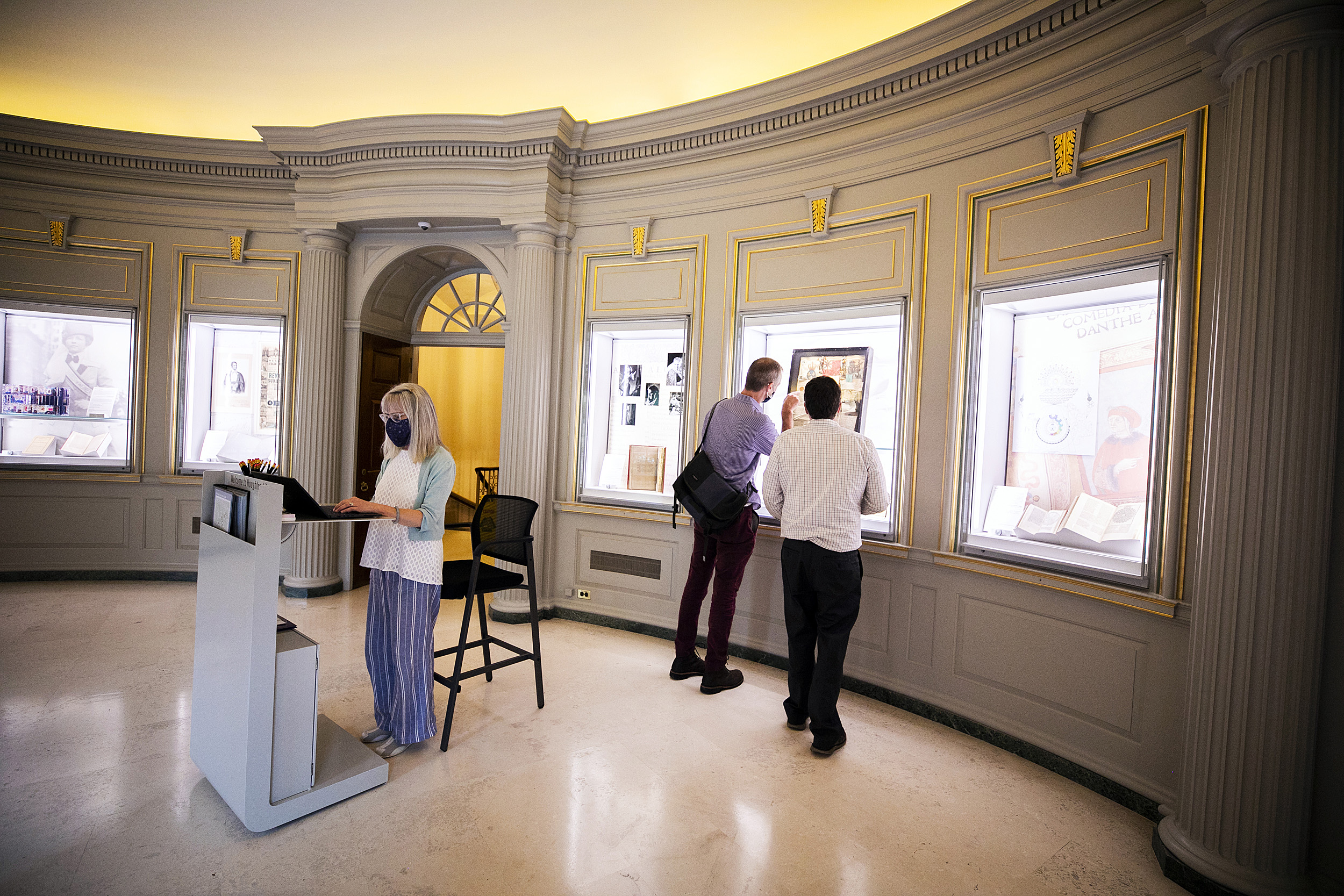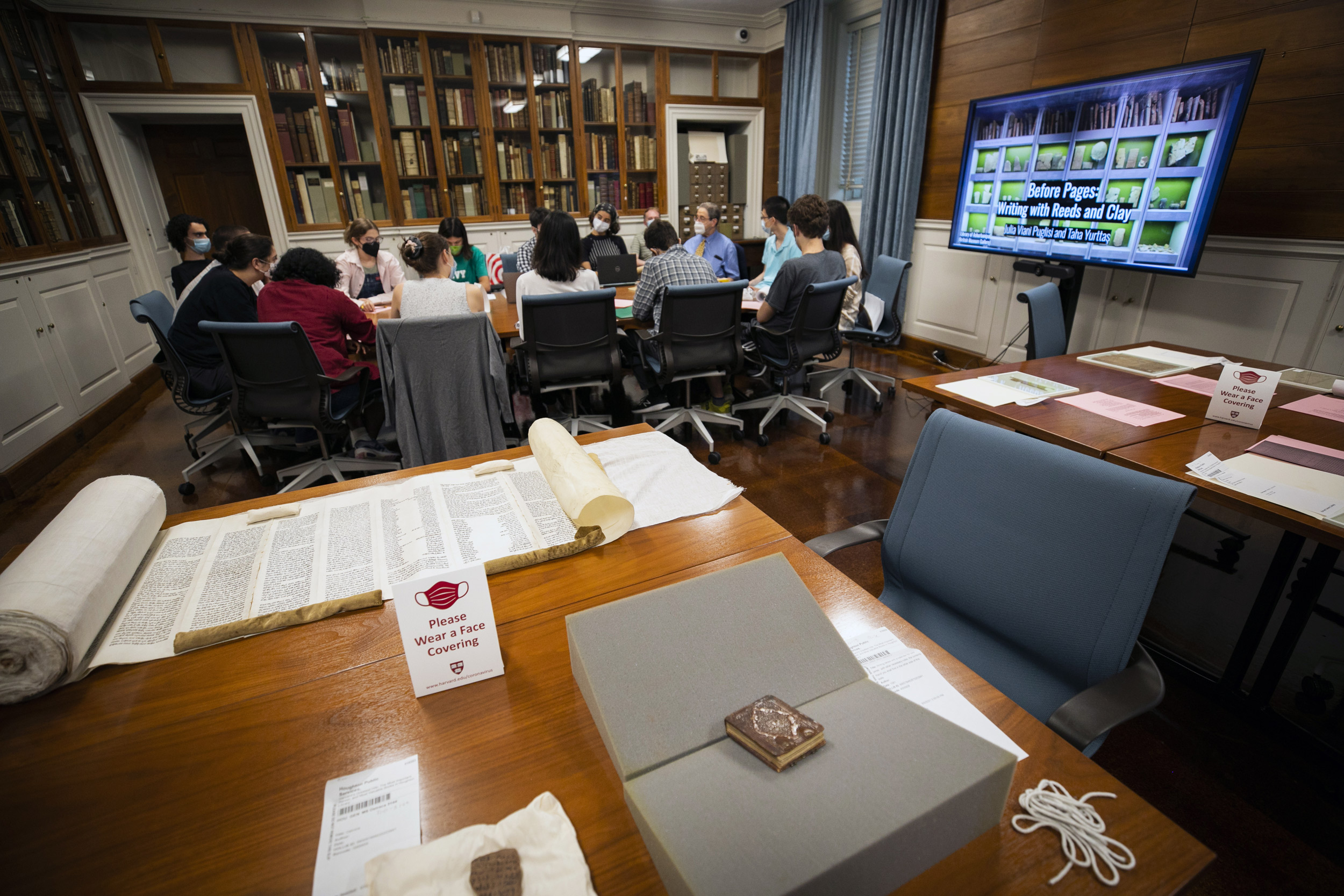
Lewis Day (pictured) speaks from the new reading room desk.
Photos by Stephanie Mitchell/Harvard Staff Photographer
Users give Houghton renovation a thumbs-up
Improvements include better accessibility, expanded exhibition spaces, updated classrooms
Literature Professor David Stern had planned to teach his first-year seminar, “Harvard’s Greatest Hits,” on the history of books and their physical forms, last academic year in a newly renovated space at Houghton Library.
But due to the pandemic, Houghton was closed for nearly double the 12 months scheduled for its renovation. It wasn’t until after the library reopened to students, faculty, and staff in September that Stern finally found himself back in its classrooms, leading a discussion on materiality as his students examined shards of pottery, delicate papyrus fragments, and parchment scrolls.
Teaching in the new Houghton, he said, was worth the wait.
“It’s spectacular,” said Stern, Harvard’s Harry Starr Professor of Classical and Modern Jewish and Hebrew Literature. “It’s more welcoming, more friendly. I’m so impressed with the job they did.”
In a typical year, Houghton engages a multitude of scholars and is one of the libraries at Harvard that receives the most visitors from outside the University. The world-renowned research center and teaching laboratory holds millions of primary sources and hosts open exhibitions and events every year, as well as nearly 300 visits from classes like Stern’s. It is expected to reopen to visiting researchers on Monday.
When construction on the building was completed in February, library staff couldn’t wait for its safe reopening to users, said Thomas Hyry, the Florence Fearrington Librarian of Houghton Library.
“As wonderful as it was to see construction completed, we were even more excited for the day when the spaces could be used again,” Hyry said. “The work done to renovate Houghton was meant to be appreciated not only by staff members but by students, faculty, and the community.”
After all, he said, the vision for the project was to create a more welcoming and accessible building that all community members could use and enjoy.
The renovation was led by Ann Beha Architects in partnership with the Faculty of Arts and Sciences’ Office of Physical Resources and Planning. It was funded in part by generous gifts from alumni, including Peter J. Solomon ’60, M.B.A. ’63, and his wife, Susan, who also gave a children’s literature collection to the library and an additional gift to construct a new gate in Harvard Yard.
The reopening of all library buildings this year has been gratifying, said University Librarian Martha Whitehead, and Houghton especially so.
“Library users are returning to a space that is instrumental to their teaching, learning, or research,” Whitehead said. “In addition to this, Houghton is now an enhanced version of the space they knew and can serve their needs even better than before.”
On a brief tour through the building this month, Hyry pointed out some of the new things he and his colleagues are most excited for users to experience.
Improved accessibility
The changes to Houghton are evident before stepping through its doors, as the front of the building now includes a grand staircase and two wheelchair-accessible paths — as well as the new Appell Plaza, gift of the Powder Mill Foundation in honor of Louis J. Appell Jr. ’47, and Josephine S. Appell. These renovations are part of a conscious shift to make Houghton easier to navigate, Hyry said.
Inside the building, new features include visitor elevators and lockers; gender-neutral, wheelchair-accessible restrooms; modernized wayfinding and signage; and a welcome ambassador in the lobby to greet and provide information to visitors.
A map and library guide are available to visitors at the welcome desk.

Expanded exhibition spaces
Houghton’s bright, freshly painted lobby now boasts new exhibition and display spaces that left researcher and frequent Houghton user Elizabeth Rudy “gushing” on her first visit to the reopened building.
Display cases in the oval lobby have replaced bookcases and will highlight changing samples of Houghton’s varied and diverse collections. The exhibit currently includes an 11th-century Quranic manuscript, an early draft of Sylvia Plath’s poem “Sickroom Tulips,” and two books printed in the Massachusett language at the Harvard Indian College in the late 1600s.
An additional new case located off the lobby displays materials related to historical intellectual breakthroughs, especially in the history of science. The displayed materials come from Houghton as well as an anonymous alumni donor who generously funded the renovation of the library’s reading room. The fall 2021 installation on “Nicolaus Copernicus’ Sun-Centered Solar System” features materials by Copernicus and his pupil Rheticus.

All the new cases and lighting were designed by Boston-based firm IKD, whose principals are Harvard alumni Yugon Kim, M.Arch. ’04, and Tomomi Itakura, M.Arch. ’04, and partially funded by the David P. Wheatland Charitable Trust.
Rudy, the Carl A. Weyerhaeuser Curator of Prints at the Harvard Art Museums, who was one of the first researchers to return to Houghton in person this month, said she was “blown away” by the renovated exhibition spaces, as well as the information in the exhibits themselves.
“It’s a transformed, inspiring group of spaces,” Rudy said. “I learned so much in just a short period of time.”
Inaugural exhibit — ‘Animals Are Us’
The first special exhibition in the renovated building is “Animals Are Us: Anthropomorphism in Children’s Literature,” featuring many items from the Peter J. Solomon Collection recently gifted to the library. In 2018, Solomon gave Houghton a rare first edition of “Alice in Wonderland,” also pledging to donate the rest of his collection and underwrite the library’s renovation.
“Peter has become a major supporter of Houghton and his generosity has had a significant impact on the library in many ways,” said Hyry. “His collection has enabled us to install an exhibition that at once welcomes a broad audience and engages critically with and gives us new ways to think about a well-known genre of literature.”
“Animals Are Us” explores the whimsy and creativity of stories about animals, Hyry said, as well as raises questions about why such characters are so common and whether this comes at the expense of diverse human characters.
The exhibition was guest curated by H. Nichols B. Clark ’69, founding director and chief curator emeritus of the Eric Carle Museum of Picture Book Art, and Meghan Melvin, Jean S. and Frederic A. Sharf Curator of Design in the Department of Prints and Drawings at the Museum of Fine Arts in Boston. It opened on Sept. 1 and will run until Jan. 7, 2022.
Reading room
Houghton’s reading room has been brightened, modernized, and made more accessible. The room was refurnished with ADA-accessible tables, adjustable-height chairs, comfortable armchairs, and glowing overhead lighting. The walls are now a calming blue and ivory, and soundproof glass separates a help-desk area and group study room from the main room.
Hyry said the additional spaces within the reading room will allow for different kinds of engagement between researchers, librarians, and collections. A researcher new to the library could ask questions about a collection without disturbing other users, for instance, or a group of students in the same class could examine and discuss materials together.
For solo researchers like Rudy, meanwhile, the main room is now quieter and enables better focus. Rudy said it’s the perfect place, after using HathiTrust for months, for her to “reunite with the texts.”


Lewis Day is pictured at the new reading room desk.
Teaching spaces
The classrooms feature upgraded technology and furniture. Stern, who has visited with his class, said aesthetic changes make the rooms feel brighter, while new technology and movable furniture mean the spaces are “much more flexible” for collaborative work and engaging with collection materials.
Doctoral candidate Julia Viani Puglisi, who is studying Egyptology, presented to Stern’s class in September. She said being in the new classrooms underscored the importance of multimedia learning.

Puglisi is all for digitizing library materials; in fact, she worked on a 2019 project to three-dimensionally scan ancient pottery shards held at Houghton and make them available to students. But she also thinks the materiality of the objects — what they’re made of, their texture, their shape — can only be really understood in person.
In the new Houghton, with cutting-edge technology in the same spaces as thousand-year-old objects, users can now have both.




